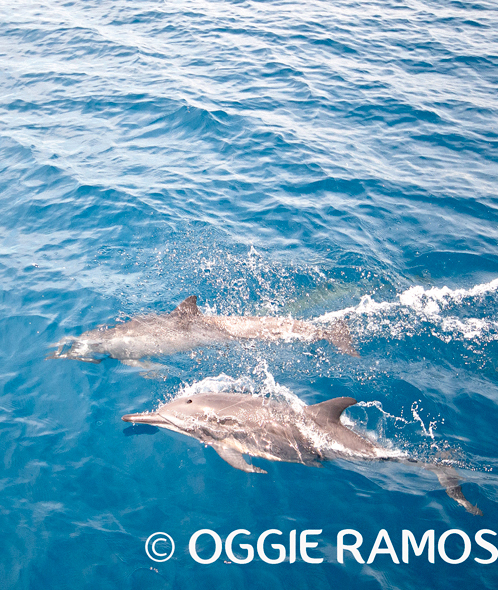 |
| Sailing with the dolphins in Bais • Image for Oceana Philippines |
We make an excursion southwest across Tañon strait to Bindoy in Negros Oriental (located less than 2 hours drive from Dumaguete City) to meet, talk and share lunch with Mayor Valente Yap. The shallow water near the mangrove areas meant we have to ride a rubber raft from the liveaboard heading to what Yas aptly calls the Mangrove Pavilion. It was a hot day and the locals certainly didn't want to waste another minute in the sweltering heat, not when the clear, cool waters under the mangroves were too inviting for a swim.
 |
| Out for a dip in Bindoy's mangrove sanctuary |
After a nice lunch, we hunkered down for a tete-a-tete with Mayor Yap who shared his insights on how preserving the mangroves and keeping the periphery free from large-scale fishing have brought back the fish catch volume in recent years. As Negros' lone municipality, Bindoy has an interesting mountain to mangrove to sea grass preservation program, a clear cut demonstration of the interdependence of the different terrestrial environments. I have a special spot for environmental conservation and it was immediately sensible to me why preserving the mountains help prevent heavy siltation and run-off that can harm the sea waters below (hence the reference to sea grasses). The mangroves are natural windbreakers that also provide a habitat for fishes, especially the young fry which would otherwise be easy prey to predators. The place has seen incremental increase in fish catch over the past few years as slowly, the locals have caught on in the program.
We later visited another mangrove sanctuary farther out along the coast before heading to the reef station in Mantalip. By sunset, the waters have receded, exposing the rocks and necessitating transfer by kayak to the guard station that sits on stilts in the middle of the sea. When I first saw this item on our itinerary, I was expecting a claustrophobic hut in the middle of nowhere. To my (our) surprise, we instead saw a concrete structure complete with sleeping accommodations and t&b for guests. It was a novel experience for me as it was a rather sublime experience to find myself spending the night literally above the reef, listening to the crashing of the waves as I eat, shoot and sleep.
 |
| Mantalip Reef guard station and Harold Dive Center's liveaboard before sunrise |
 |
| Days 5-6 Route Map by Oggie Ramos |
Notes: This post is 5th in a series of features for our 6-day photo safari along Tañon Strait for Oceana Philippines. Oceana is dedicated to helping protect and restore the world's oceans on a global scale. In the Philippines, the local office of Oceana is seeking to restore the health, richness, and abundance of our local oceans by ensuring sustainable fisheries and vibrant marine ecosystems.
Special thanks go to Harold Biglete of Harold's Dive Center. If you happen to find yourself in Dumaguete, check out his place, Harold's Mansion located along Hibbard Street just minutes away from the boulevard. Harold, himself a PADI-certified instructor, has two liveaboards available for guests who would want to dive in the area.
Read Part 4 of this series: Notes from Tañon Strait, Day 4: Missing the Sardine Run in Moalboal, Getting Inspired in Hale Manna

